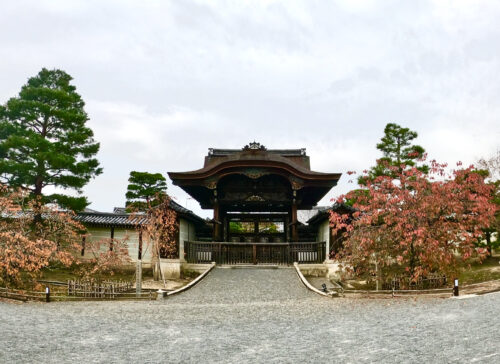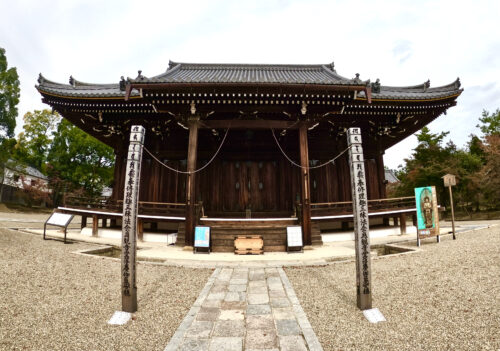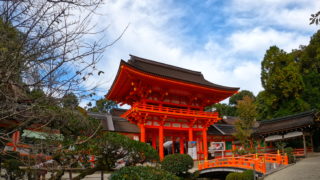Ninnaji Temple 【仁和寺】

仁和寺公式ホームページ


Ninnaji Temple was built by Emperor Uda in 888.
The principal image is Amida Nyorai.
The descendants of successive emperors served as priests.
Thirty generations have protected this temple.
Currently, it is the head temple of the Shingon sect Omuro faction.
仁和寺(にんなじ)
仁和寺は888年 第59代宇多天皇によって建てられた寺院で、本尊は阿弥陀如来です。
歴代の天皇の子や孫が住職となっていった門跡寺院であり、創建から30代に渡って引き継がれた筆頭の門跡寺院です。
現在は真言宗御室派の総本山です。
The national treasure Kondo hall 【国宝 金堂】

The national treasure Kondo hall was relocated from the Main Hall of the Kyoto Imperial Palace from 1622 to 1644.
On the back of the Kondo hall, there is a mural painting of the Five Great Myo Kings, a national treasure.
It was closed for 372 years. It was first released to the public in October 2018.
It was out of the sun, and the mural paintings of the Five Wisdom Kings remained almost intact.
The Fudo Myo, depicted in the center, has a very scary face, but is said to be a benevolent Buddha.
In the right hand is the Hoto sword that solves the problem, and in the left hand is the Ken-jaku called the rope of salvation.
国宝 金堂
1622〜1644年に京都御所の正殿・紫宸殿を移築しました。現存する紫宸殿としては最古の建物です。
金堂裏堂には国宝の五大明王壁画が描かれています。372年間非公開だった壁画が2018年10月に初公開されました。
陽が当たらない場所にあり、ほぼ劣化せずに金剛薬叉明王 降三世明王 不動明王 軍荼利明王 大威徳明王の五大明王が描かれているそうです。
中心に描かれている不動明王は、憤怒相(ふんぬそう)といって、非常に怖い顔をしていますが、慈悲深い仏様とされています。
右手には煩悩を断ち切る宝剣と左手には救いの縄とされている羂索(けんじゃく)を持っていることが特徴です。
Niomon Gate 【仁王門】


It is one of the “Three Great Gates of Kyoto” along with Chioin Temple and Nanzenji Temple.
On the left and right sides of the gate are the statues of Nio and Karashishi.
仁王門 知恩院の三門、南禅寺の三門とともに、「京都三大門」の一つです。門の左右には金剛力士像と唐獅子像が安置されています。
Honbo 【本坊】

On the west side, there is a Honbo called “Ninnaji Temple Palace”.
Passing through the main gate, you will find the main shrine where the official ceremony is held. Seasonal painting of fusuma is lined up.
本坊 仁王門を通ると西側には、「仁和寺御殿」と呼ばれる本坊があります。本坊表門を通ると公式な儀式を行う宸殿などがあります。四季折々の絵が描かれた襖絵がならんでいます。
Chokushimon Gate (Imperial envoy gate) 【勅使門】
Only the emperor or the emperor’s envoy can pass through the Chokushimon Gate.
Only Mikoshi, which was carried at the festival in October, can pass from Fukuoji Shrine, which enshrines Emperor Uda’s mother.
勅使門 本坊に入るための門ですが、天皇陛下の行幸または、天皇のお使いの者だけが通ることができるとされています。宇多天皇の母君を祀っている福王子神社から、10月にあるお祭り(福王寺大祭)で運ばれた神輿は通ることができるそうです。
North garden 【北庭】
This garden is located in Honbo and has a pond and tea room with beautiful views of the five-storied pagoda.
The place where you can see the five gates of Niomon Gate, Chokushimon Gate, Kozokumon Gate, Nakamon Gate, and Yakushimon Gate is a power spot.
北庭 本坊内にある庭園で、池や茶室があり、五重塔が見える大変景色の良い場所です。仁王門 勅使門 皇族門 中門 薬医門の5つの門が見える場所があり、パワースポットとして有名です。
Reimeiden palace 【霊明殿】
This building is located in Honbo and enshrines the bodies of successive emperors (monks).
The principal image is Yakushi Nyorai. This statue was considered a secret Buddha statue, but when it was examined in 1988, it was designated as a national treasure in 1990 because it was an old and fine Yakushi Nyorai.
Yakushi Nyorai is a small statue of 10.7 cm, and the height including the pedestal is only 22 cm. It is the smallest Buddha statue in Japan as a national treasure.
霊明殿 本坊内にあり、歴代の御門跡(皇子、皇族の住職)のご遺体をお祀りしている建物です。
ご本尊は薬師如来で秘仏とされていましたが、1988年に調査したところ、大変古い立派な薬師だったため、1990年に国宝に指定されました。
10.7cmの小さな薬師如来像で、台座を含めても高さ22cmしかありません。国宝の仏像としては日本一小さな仏像とされています。
Mizukake Fudoson 【水掛不動尊】
Fudo Myoo is enshrined. The well is filled with water that springs from the mountains in the back.
Scoop up the water with a long dipper and sprinkle water on Fudo Myoo to make your wish come true.
In the foreground is “Kanko koshikakeishi Stone”.
It is the origin of the name of this stone.
Sugawara no Michizane, who was an aide to Emperor Uda, was dismissed from the minister, demoted to Dazaifu, and was waiting while sitting on this stone to say goodbye to Emperor Uda.
水掛不動尊 不動明王が祀られています。裏山から湧き出る水が井戸に貯められおり、長い柄杓で水をすくい、不動明王に掛けると願いが叶うと言われています。
手前には「菅公腰掛石(かんこうこしかけいし)」があります。
宇多天皇の側近だった菅原道真が右大臣の職を解かれて太宰府に左遷されることになり、宇多天皇に別れの言葉を告げるためにこの石に座って留守だった宇多天皇の帰りを待っていたことがこの石の由来だと言われています。
Mieido House 【御影堂】

It was built using the materials of Seiryoden Hall, the Kyoto Imperial Palace, which enshrines Kukai and Emperor Uda.
In the olden days, it was said that after visiting “3 kobos in Kyoto”, we would visit 88 places in Shikoku, and this Mieido House is one of the 3 kobos in Kyoto.
(Kobo is a building enshrining Kukai)
御影堂 弘法大師空海、宇多天皇を祀っている 京都御所の清涼殿の用材を用いて建築しました。
昔から京都三弘法巡りのあと四国88ヶ所巡りをするとされていて、この御影堂は京都三弘法の一つとなっています。


Omune 88kasho reiba (88 pilgrimage sites) 【御室八十八ヶ所霊場】
If you go out the west gate and climb Mt. Joju, you will find “Omune 88kasho reiba (88 pilgrimage sites)”.
In 1827, Saiin houshino, the 29th priest of Niwaji, returned with sand from 88 sacred sites in Shikoku. And I buried it in Mt. Joju to make a sacred place.
It was difficult to visit 88 places in Shikoku, so by worshiping here, I was able to get the same benefits as 88 places in Shikoku. It is a place with a good view overlooking Kyoto city.
御室八十八ヶ所霊場 西門を出て、成就山を登ると御室八十八ヶ所霊場があります。
四国八十八ヶ所を巡ることが困難であったため、1827年、仁和寺29世門跡済仁法親王が四国八十八ヶ所霊場の砂を持ち帰り、成就山山道に埋め霊場を整備したとされています。ここで、四国八十八ヶ所を巡ったことと同じ功徳をもらえるとしました。京都市内一望できる眺めの良い場所です。
Kannon-do Hall 【観音堂】

The building was restored in six years from 1641 to 1646.
The principal image is the Senju Kannon Bodhisattva. And
Fudo Myoo and Gozanze Myo are on both sides.
In addition, a statue of the god of wind, a statue of the god of thunder, and 28 Buddha statues are lined up, and a total of 33 Buddha statues are enshrined.
It is not normally open to the public. However, it has been used as a place of worship on the 18th of every month since 2010.
You can watch the Kannon-do VR promotion video on the YouTube channel of Ninna-ji Temple.
観音堂 1641年〜1646年に6年かけて修復された建物です。本尊は千手観音菩薩で、両脇に不動明王と降三世明王が安置されています。そして、風神像と雷神像、二十八部衆を合わせて、33体の仏様を祀っています。
普段は公開していませんが、令和2年度から毎月18日に「観音会」を開き、観音堂を信仰の道場として祈願の場としています。
仁和寺YouTubeチャンネルで観音堂のVRプロモーション動画を観ることができます。
京都・総本山 仁和寺 VRプロモーションビデオ 観音堂
Gojunoto Pagoda 【五重塔】



There are four Gojunoto Pagoda in Kyoto. Toji Temple, Daigoji Temple, Hokanji Temple (Pagoda in Yasaka) and Ninnaji Temple.
Gojuno Pagoda at Ninnaji Temple is 36.18 meters high and has the same roof width from the 1st floor to the 5th floor. The feature is that it is a pure Japanese-style building.
五重塔 京都には4つの五重塔があります。東寺 醍醐寺 法観寺(八坂の塔) そして仁和寺です。
仁和寺の五重塔は、高さ36.18mあり、一層から五層まで屋根の幅が同じで純和風の建築物であることが特徴です。





















コメント